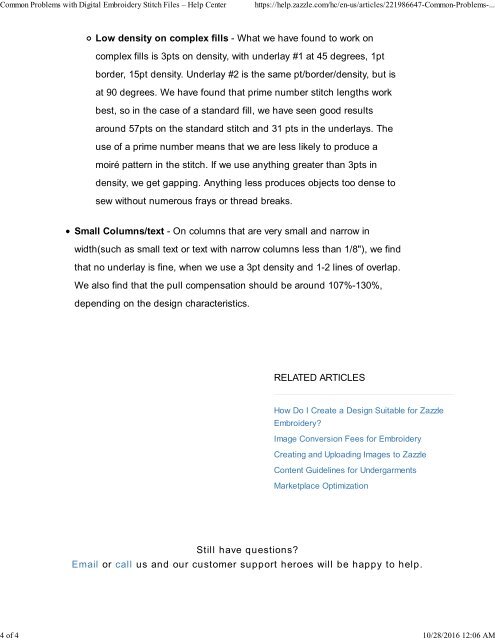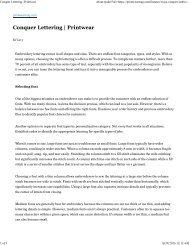Embroidery Basics Articles
Create successful ePaper yourself
Turn your PDF publications into a flip-book with our unique Google optimized e-Paper software.
Common Problems with Digital <strong>Embroidery</strong> Stitch Files – Help Center<br />
https://help.zazzle.com/hc/en-us/articles/221986647-Common-Problems-...<br />
4 of 4 10/28/2016 12:06 AM<br />
Low density on complex fills - What we have found to work on<br />
complex fills is 3pts on density, with underlay #1 at 45 degrees, 1pt<br />
border, 15pt density. Underlay #2 is the same pt/border/density, but is<br />
at 90 degrees. We have found that prime number stitch lengths work<br />
best, so in the case of a standard fill, we have seen good results<br />
around 57pts on the standard stitch and 31 pts in the underlays. The<br />
use of a prime number means that we are less likely to produce a<br />
moiré pattern in the stitch. If we use anything greater than 3pts in<br />
density, we get gapping. Anything less produces objects too dense to<br />
sew without numerous frays or thread breaks.<br />
Small Columns/text - On columns that are very small and narrow in<br />
width(such as small text or text with narrow columns less than 1/8"), we find<br />
that no underlay is fine, when we use a 3pt density and 1-2 lines of overlap.<br />
We also find that the pull compensation should be around 107%-130%,<br />
depending on the design characteristics.<br />
RELATED ARTICLES<br />
How Do I Create a Design Suitable for Zazzle<br />
<strong>Embroidery</strong>?<br />
Image Conversion Fees for <strong>Embroidery</strong><br />
Creating and Uploading Images to Zazzle<br />
Content Guidelines for Undergarments<br />
Marketplace Optimization<br />
Still have questions?<br />
Email or call us and our customer support heroes will be happy to help.




